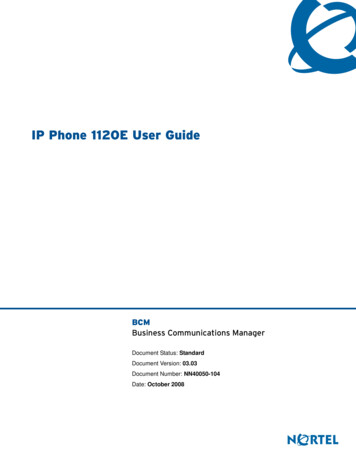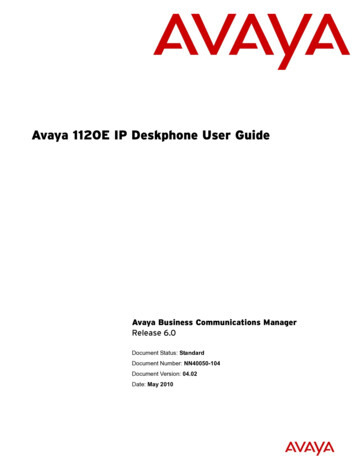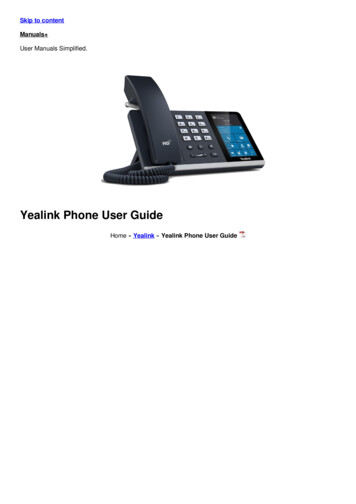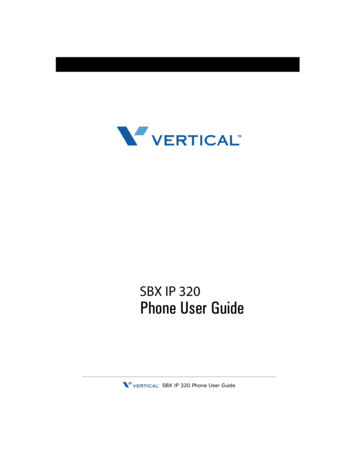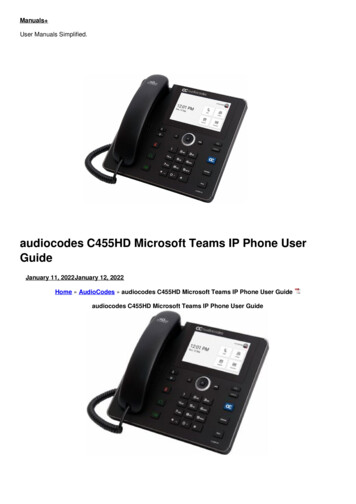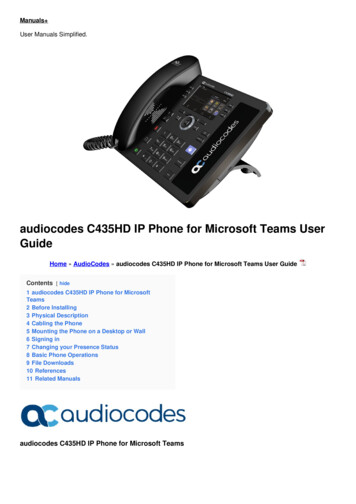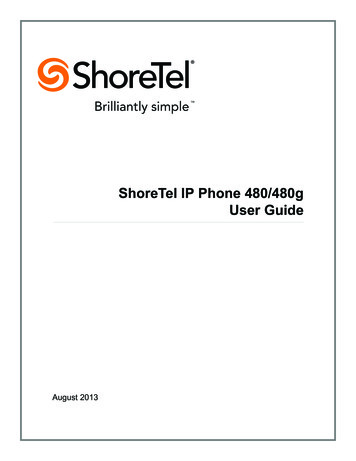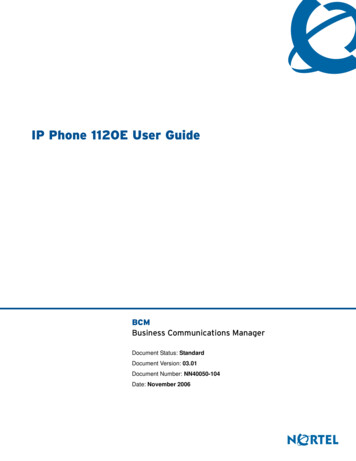
Transcription
IP Phone 1120E User GuideBCMBusiness Communications ManagerDocument Status: StandardDocument Version: 03.01Document Number: NN40050-104Date: November 2006
Copyright Nortel Networks Limited 2006, All rights reserved.The information in this document is subject to change without notice. The statements, configurations, technical data, andrecommendations in this document are believed to be accurate and reliable, but are presented without express or impliedwarranty. Users must take full responsibility for their applications of any products specified in this document. Theinformation in this document is proprietary to Nortel Networks.TrademarksNortel, the Nortel logo, and the Globemark are trademarks of Nortel Networks.Microsoft, MS, MS-DOS, Windows, and Windows NT are registered trademarks of Microsoft Corporation.All other trademarks and registered trademarks are the property of their respective owners.
Contents3ContentsChapter 1About the Nortel IP Phone 1120E . . . . . . . . . . . . . . . . . . . . . . . . . . . . . . . . . . 5Basic Features . . . . . . . . . . . . . . . . . . . . . . . . . . . . . . . . . . . . . . . . . . . . . . . . . . . . . . . . 5Telephone Controls . . . . . . . . . . . . . . . . . . . . . . . . . . . . . . . . . . . . . . . . . . . . . . . . . . . . 7Telephone Display . . . . . . . . . . . . . . . . . . . . . . . . . . . . . . . . . . . . . . . . . . . . . . . . . . . . 11Chapter 2Entering and editing text . . . . . . . . . . . . . . . . . . . . . . . . . . . . . . . . . . . . . . . . 13Entering text using the telephone dialpad . . . . . . . . . . . . . . . . . . . . . . . . . . . . . . . . . . 13Entering text using the USB keyboard . . . . . . . . . . . . . . . . . . . . . . . . . . . . . . . . . . . . . 13Chapter 3Configuring options. . . . . . . . . . . . . . . . . . . . . . . . . . . . . . . . . . . . . . . . . . . . 151. Preferences . . . . . . . . . . . . . . . . . . . . . . . . . . . . . . . . . . . . . . . . . . . . . . . . . . . . . . . 151. Display Settings . . . . . . . . . . . . . . . . . . . . . . . . . . . . . . . . . . . . . . . . . . . . . . . . 152. Language . . . . . . . . . . . . . . . . . . . . . . . . . . . . . . . . . . . . . . . . . . . . . . . . . . . . . 152. Local Diagnostics . . . . . . . . . . . . . . . . . . . . . . . . . . . . . . . . . . . . . . . . . . . . . . . . . . 161. IP Set&DHCP Information . . . . . . . . . . . . . . . . . . . . . . . . . . . . . . . . . . . . . . . . . 162. Network Diagnostic Tools . . . . . . . . . . . . . . . . . . . . . . . . . . . . . . . . . . . . . . . . . 163. Ethernet statistics . . . . . . . . . . . . . . . . . . . . . . . . . . . . . . . . . . . . . . . . . . . . . . . 164. IP networks statistics . . . . . . . . . . . . . . . . . . . . . . . . . . . . . . . . . . . . . . . . . . . . . 165. USB device information . . . . . . . . . . . . . . . . . . . . . . . . . . . . . . . . . . . . . . . . . . . 163. Network Configuration . . . . . . . . . . . . . . . . . . . . . . . . . . . . . . . . . . . . . . . . . . . . . . . 174. Lock Menu . . . . . . . . . . . . . . . . . . . . . . . . . . . . . . . . . . . . . . . . . . . . . . . . . . . . . . . . 17Chapter 4Telephone setup. . . . . . . . . . . . . . . . . . . . . . . . . . . . . . . . . . . . . . . . . . . . . . . 19Language choice . . . . . . . . . . . . . . . . . . . . . . . . . . . . . . . . . . . . . . . . . . . . . . . . . . . . . 19Ring Type . . . . . . . . . . . . . . . . . . . . . . . . . . . . . . . . . . . . . . . . . . . . . . . . . . . . . . . . . . 19Call log . . . . . . . . . . . . . . . . . . . . . . . . . . . . . . . . . . . . . . . . . . . . . . . . . . . . . . . . . . . . . 19Time offset . . . . . . . . . . . . . . . . . . . . . . . . . . . . . . . . . . . . . . . . . . . . . . . . . . . . . . . . . . 19About your programmable buttons . . . . . . . . . . . . . . . . . . . . . . . . . . . . . . . . . . . . . . . 20Memory buttons . . . . . . . . . . . . . . . . . . . . . . . . . . . . . . . . . . . . . . . . . . . . . . . . . . 20Program memory buttons . . . . . . . . . . . . . . . . . . . . . . . . . . . . . . . . . . . . . . . . . . . 20Making a call . . . . . . . . . . . . . . . . . . . . . . . . . . . . . . . . . . . . . . . . . . . . . . . . . . . . . . . . 21Answering a call . . . . . . . . . . . . . . . . . . . . . . . . . . . . . . . . . . . . . . . . . . . . . . . . . . . . . 22While on an active call . . . . . . . . . . . . . . . . . . . . . . . . . . . . . . . . . . . . . . . . . . . . . . . . . 22Placing a call on hold . . . . . . . . . . . . . . . . . . . . . . . . . . . . . . . . . . . . . . . . . . . . . . 22Using handsfree . . . . . . . . . . . . . . . . . . . . . . . . . . . . . . . . . . . . . . . . . . . . . . . . . . . . . 22IP Phone 1120E User Guide
4ContentsUsing a headset . . . . . . . . . . . . . . . . . . . . . . . . . . . . . . . . . . . . . . . . . . . . . . . . . . . . . . 22Muting the Microphone . . . . . . . . . . . . . . . . . . . . . . . . . . . . . . . . . . . . . . . . . . . . . . . . 22Accessing External Server Applications . . . . . . . . . . . . . . . . . . . . . . . . . . . . . . . . . . . 23NN40050-104
5Chapter 1About the Nortel IP Phone 1120EThe Nortel IP Phone 1120E brings voice and data to the desktop by connecting directly to a LocalArea Network (LAN) through an Ethernet connection.Note: In this guide, user-defined feature key labels appear beside the keys, andsoft key labels appear directly above the keys.Basic FeaturesYour IP Phone 1120E supports the following: four user-defined feature keys with labels and indicatorsfour soft keysNote: Some IP Phone 1120E phones are not configured to support soft keyfunctionality. Consult your system administrator. graphical, high-resolution LCD display, backlit, with adjustable contrasthigh-quality speaker phonevolume control keys for adjusting ringer, speaker, handset, and headset volumesix specialized feature keys:— Quit— Directory— Message/Inbox— Shift/Outbox— Services— Copysix call-processing fixed keys:— Mute— Handsfree— Goodbye— Expand to PC— Headset— Holdgigabit Ethernet portsbuilt-in gigabit Ethernet switch for shared PC accessheadset jack with an On/Off keyIP Phone 1120E User Guide
6Chapter 1 About the Nortel IP Phone 1120E USB port to support a keyboard or mouseNote: Powered downstream 1.1-complaint USB hubs are supported, includingUSB 2.0 hubs, if they offer USB 1.1 backwards compliancy. automatic network configurationhearing-aid compatibilityCaution: Do not plug the IP Phone 1120E into a regular telephone jack. Thisresults in severe damage to the IP Phone. Consult your system administrator toensure that you plug your telephone into a 10/100/1000BaseT Ethernet jackCaution: The IP Phone 1120E is designed for use in an indoor environment only.NN40050-104
Chapter 1 About the Nortel IP Phone 1120E7Figure 1 shows the IP Phone 1120E.Figure 1 IP Phone 1120EUser-defined feature keysVisual Alerter/Message WaitingindicatorFeature Status Lamp*HandsetHigh-resolutiongraphical display screenSoft keysSpeakerNavigation keysMessage/Inbox keyShift/Outbox keyDirectory keyCopy keyServices keyQuit/Stop keyGoodbye keyVolume controlExpand to PC keyHeadset keyMute keyHandsfree keyHold keyDialpad*Note: If supported by your server, the Feature Status Lamp provides a user-defined alert.Contact your system administrator to find out if this feature is available for you.Telephone ControlsNote: Some IP Phone 1120E phones are equipped with optional key caps. Text inparentheses indicates labels appearing on the key caps, for example, (Services).FwdFeatureSoft keys are located below the displayarea. The LCD label above each keychanges based on the active feature.The Feature key is located on the bottomleft of the display area and is used foraccessing different phone options such aschanging the ring type (Feature *6)IP Phone 1120E User Guide
8Chapter 1 About the Nortel IP Phone 1120EThe keys on either side of the display areaare user-defined feature keys, with labelson the LCD display.A steady LCD light beside a line (DN) keyindicates that the line is active. A flashingLCD light indicates the line is on hold or thefeature is being programmed.GrpCl Z(Volume )(Volume -)(Mute)A steady LCD light beside a feature keyindicates that the feature is active. A flashingLCD light indicates that the feature is beingprogrammed.Use the Volume control buttons to adjustthe volume of the ringer, handset, headset,speaker, and the Handsfree feature. Pressthe top button to increase the volume, andpress the bottom button to decrease volume.Press the Mute key to listen to the receivingparty without transmitting. Press the Mutekey again to return to two-way conversation.The Mute key applies to handsfree, handset,and headset microphones.Note: The Mute LED indicator, locatedon the Mute key, flashes to indicate thatthe microphone is muted.Press the Handsfree key to activatehandsfree.(Handsfree)Note: The Handsfree LED indicator,located on the Handsfree key, lights toindicate when handsfree is active.Use the Navigation keys to scroll throughmenus and lists appearing on the LCDdisplay screen. The outer part of this keycluster rocks for up, down, left, and rightmovements.NN40050-104
Chapter 1 About the Nortel IP Phone 1120E9Use the Send/Enter key, at the center of theNavigation key cluster, to confirm menuselections.In most menus, you can use the Send/Enterkey instead of the Select soft key.(Hold)Press the Hold key to put an active call onhold. Tap the flashing line (DN) soft key toreturn to the caller on hold.Use the Expand to PC key to accessexternal server applications.(Expand)(Headset)Press the Headset key to answer a callusing the headset or to switch a call from thehandset or handsfree to the headset.Note: The Headset LED indicator,located on the Handsfree key, lights toindicate that the headset is in use.(Goodbye)Use the Goodbye key to terminate an activecall.When a message is waiting, the red VisualAlerter/Message Waiting indicator flashes.Also, when the ringer sounds, this indicatorflashes.When your IP Phone 1120E firmware isbeing updated, the blue Feature StatusLamp indicator flashes.Note: To find out if additional featuresare supported, contact youradministrator.(Copy)Press the Copy Key to copy entries to yourPersonal Directory from other lists, such asthe Caller List, Redial List, and CorporateDirectory.IP Phone 1120E User Guide
10Chapter 1 About the Nortel IP Phone 1120E(Services)(Services)(Services)Press the Services key to access thescrollable Feature Display menu (FEATURE*900), including the hot desking feature(programmable memory button).Press the Services key twice to access theLocal Tools menu, and use the navigationkeys to access the following items: 1. Preferences 2. Local Diagnostics 3. Network Configuration 4. Lock MenuNote: Your system administrator canestablish a password for the Toolsmenu. If you attempt to access the Toolsmenu and a dialog box appearsprompting you for a password, contactyour system ctory)NN40050-104Press the Quit/Stop key to close an activemenu or dialog box. Pressing the Quit/Stopkey does not affect the status of active calls.Press the Express messaging key(FEATURE 980; programmable memorybutton) to send voice mail messages. Formore information about voice mailmessaging, refer to your CallPilot QuickReference Card.Press the Mailbox in key (programmablememory button) to open your CallPilotmailbox. For more information about mailboxoptions, refer to your CallPilot QuickReference Card.Programmable memory button(Default: Blank)
Chapter 1 About the Nortel IP Phone 1120E11Telephone DisplayYour IP Phone 1120E has three display areas: The upper display area provides labels for the four user-defined feature keys.The middle display area contains single-line information for items such as caller number,caller name, feature prompt string, user-entered digits, date and time information, andtelephone information.The lower display area provides labels for the four soft keys.Figure 2 shows an idle LCD screen.Figure 2 IP Phone 1120E LCD screenUpper display areaUser-definedfeature key labelsMiddle display areaDate/time displayCall party informationFeature status informationOptions informationDirectories information47678AutoDial42888234810/30 4:30pmTransConfForwardMore.Lower display areaSoft keysIP Phone 1120E User Guide
12Chapter 1 About the Nortel IP Phone 1120ENN40050-104
13Chapter 2Entering and editing textYou can enter and edit text on your IP Phone 1120E using the following methods.Which method you use for text entry or editing depends on the application. Table 1 shows theapplications and input devices that you can use for text entry.Table 1 Application text entryFor:Use:Call Server-related applications(for example, changing featurekey labels or dialing)DialpadUSB keyboard for numeric entriesonlyUSB keyboardUSB keyboardDialpad for numeric entriesGraphical applicationsTools menuEntering text using the telephone dialpadYou can use the dialpad to enter text. For example, if you want to enter the letter A, press thenumber 2 key once. If you want to enter the letter C, press the number 2 key three times.Note: No letters are associated with the number 1 or 0 keys.Entering text using the USB keyboardYou can use the USB keyboard, when connected, to enter text in the tools and graphicalapplications.For number entry in telephone applications (for example, when dialing), you can use the keyboardto enter digits (0–9), as well as asterisk (*) and number sign (#). Other characters are not used.When on a call, you can use the function keys (f1, f2, f3, f4, f5, f6, f7, and f8) to control thetelephone. Table 2 shows the function keys and their associated action during telephone calls.Table 2 USB keyboard function keys during telephone callsFunction Key Actionf1f2f3f4f5Go to Handsfree modeGo to Headset modePlace the current call on holdMute the current callVolume upIP Phone 1120E User Guide
14Chapter 2 Entering and editing textf6f7f8NN40050-104Volume downCopyQuit
15Chapter 3Configuring optionsNote: Many of the options discussed in this section are for administrator useonly. Do not make any changes unless instructed by an administrator.Your IP Phone 1120E has both local and server-based options. Two methods are available tonavigate in the Local Tools menu: Follow the prompts on screen.Where a menu entry has a number in front of it, you can select that entry by pressing theassociated key on the dialpad. For example, when you are in the Local Tools menu, you canaccess 2. Local Diagnostics by pressing the 2 key on the dialpad.Doube-press theoptions:(Services) key to open the Local Tools Menu and access the following1. PreferencesUse the Preferences menu item to configure local preferences.1. Display SettingsUse the Contrast tool to alter the physical settings of the display. Use the Sleep tool to control howlong the display remains lit if the phone is inactive.1Double-press2Press the 1 key on the telephone dialpad to open the 1. Preferences menu, and press the 1 keyon the telephone dialpad to open the 1. Display Settings menu.3Press the Up/Down navigation keys to scroll and select either Contrast or Sleep. Press theSelect soft key.4Press the Up/Down navigation keys to increase or decrease the value.5Press the Exit soft key.(Services) to open the Local Tools menu.2. LanguageUse the Language tool to select the language used on your phone.1Double-press2Press the 1 key on the telephone dialpad to open the 1. Preferences menu, and press the 2 keyon the telephone dialpad to open the 2. Language menu.3Press the Up/Down navigation keys to scroll and highlight the desired language (for example,German [Deutsche]).4Choose one of the following:(Services) to open the Local Tools menu.IP Phone 1120E User Guide
16Chapter 3 Configuring options Press the Select soft key to save the desired language and return to the Telephone Optionsmenu.Press the Cancel soft key to keep existing configurations.5Press the Exit soft key. Changes are saved automatically.2. Local Diagnostics1. IP Set&DHCP InformationThe Network Configuration tool is used to view reports about IP set and DHCP operation. Thistool is for administrator use only.2. Network Diagnostic ToolsThe Network Diagnostic Tools menu contains tools that are used to diagnose network problems.This menu is for administrator use only.3. Ethernet statisticsThe Ethernet statistics tool is used to view reports about Ethernet operation. This menu is foradministrator use only.4. IP networks statisticsThe IP networks statistics tool is used to view reports about network operation. This menu is foradministrator use only.5. USB device informationThe USB Devices tool provides information about any Universal Serial Bus (USB) devices thatyou connect to your phone. Your IP Phone 1120E automatically detects USB devices when youconnect them to the USB port in the back of the telephone.1Double-press2Press the 5 key on the telephone dialpad to select 5. USB Devices.USB Device information is displayed.3Press the Return soft key.NN40050-104(Services) to open the Local Tools menu.
Chapter 3 Configuring options173. Network ConfigurationThe Network Configuration tool displays information that was configured when the telephone wasinstalled. This tool is for administrator use only.4. Lock MenuThe lock menu tool is used by the system administrator to protect the Local Tools menu itemsfrom accidental or unwanted changes.The lock menu tool is not available on all systems. If the menu entry appears dimmed, it is notenabled on your phone. Contact your administrator to find out of this feature is available for youruse.IP Phone 1120E User Guide
18Chapter 3 Configuring optionsNN40050-104
19Chapter 4Telephone setupNote: For more information about the features available to your telephone andhow to use them, refer to the Telephones Feature Card.Language choiceSelect the Primary Language for the telephone display. Choose one of the following three options: Press Feature *501. Select the Alternate Language for the telephone display.Press Feature *502. Select the Alternate Language 2 for the telephone display.Press Feature *503. Select the Alternate Language 3 for the telephone display.Ring TypeSelect the ring type for your telephone:1Press Feature *6.2Press 1, 2, 3, 4, or Next to hear the different ring types.3Press OK to store the ring type.Call logPress Feature *812 and use the navigation keys to scroll through and edit the call log.Time offsetWhen your IP Phone 1120E is located in a different time zone than your system, the display showsthe system time instead of the local time. The Time Offset feature allows you to adjust the timethat appears on the display. Before you begin, calculate the time difference, in hours, between theserver time and local time.To change the time that appears on your telephone display to local time, use the following steps:1Press Feature *510.2Press Change.3Press * to switch between adding or subtracting time.IP Phone 1120E User Guide
20Chapter 4 Telephone setup4Using the dialpad, enter the number of hours between local time and system time.Note: Press # to enter half-hour increments.5Press OK.Note: It may take up to 1 minute for the change to appear on the display.About your programmable buttonsYour System Administrator assigns the four programmable buttons as line, intercom, or memorybuttons. The label for each button appears on the display next to the button. For more information,see your System Administrator.Memory buttonsThese are buttons that are not assigned as line or intercom buttons. Memory buttons store internaland external phone numbers or features to give you one-touch dialing or feature activation.Program memory buttonsYou can program a memory button with a new phone number or feature.External autodial1Press Feature *1.2Press a memory button.3Dial the external phone number.4Press OK to store the phone number.Internal autodial1Press Feature *2.2Press a memory button.3Dial the extension number.4Press OK to store the extension number.NN40050-104
Chapter 4 Telephone setup21Features1Press Feature *3.2Press a memory button.3Press Feature and enter the feature code.4Press OK to store the feature code.Erase memory buttons1Press Feature *1.2Press a memory button.3Press OK to erase the phone number saved on the button.Making a callThere are many ways to place a call depending on your telephone programming and the type ofcall.Making external calls using line soft keys1Lift the handset.2Tap a line soft key.3Dial the external telephone number.Making external calls using intercom soft keys1Lift the handset.2Tap an intercom soft key, and enter a line pool access code.3When you hear an external dial tone, dial the external telephone number.Note: Contact your system administrator for a list of line pool codes. Whenentering a line pool access code on PRI lines, you do not hear a dial tone.Making internal calls using intercom soft keys1Lift the handset.2Tap an intercom soft key.3Dial the extension number.Contact your system administrator for a list of extension numbers.IP Phone 1120E User Guide
22Chapter 4 Telephone setupAnswering a callWhen your telephone rings and the light flashes, or when an intercom or line soft key indicatorflashes: Lift the handset.OR Press the line or intercom soft key with the flashing S indicator before you lift the handset.While on an active callPlacing a call on holdCalls are put on hold automatically when you switch from one line to another. While on a call, press(Hold). TheSindicator for the line on hold flashes.To retrieve a held call, tap the line soft key with the flashing Sindicator.Using handsfreeHandsfree is not available on all phones. Contact your administrator to find our if this feature isavailable for your use. (Handsfree) to make or answer a call.PressTo switch to handsfree when you are on a handset call, press(Handsfree) and replacethe handset. Lift the handset to switch back. To switch to handsfree when you are on a headset call, pressPress(Headset) to switch back.(Handsfree)Using a headsetYou must have a headset installed on your telephone to use this feature. Press(Headset) to activate the headset mode. When thepress a line or intercom soft key to make a call.To switch to your headset when you are on a handset call, pressthe handset. Lift the handset to switch back.To switch to your headset when you are on a Handsfree call, press(Handsfree) to switch back.Muting the MicrophoneYou can useNN40050-104(Mute) on handset, handsfree, or headset calls.(Headset) light is on,(Headset) and replace(Headset). Press
Chapter 4 Telephone setup While on a call, press(Mute) to turn the microphone off. Thelights when the microphone is off.Press(Mute) again to turn the microphone on.23(Mute) buttonAccessing External Server ApplicationsUse External Server Applications to access a variety of applications directly from your IP Phone1120E.To find out what features and services are available, contact your system administrator. Dependingon what is available on your system, your phone can provide information; for example, local newsand weather, stock market information, or traffic reports.For more information about the External Server Applications, consult the Nortel IP PhoneExternal Server Applications User Guide.IP Phone 1120E User Guide
24Chapter 4 Telephone setupNN40050-104
Index25IndexCCopy Key 9copyright 2EExpand to PC key 9GGoodbye key 9HHandsfree / Speaker key 8Headset key 9Hold key 9LLine (DN) key 8MMessage waiting indicator 9Mute key 8NNavigation keys 8PProgrammable line/feature keys 8Rregulatory information 2SSoft keys 7Ttrademarks 2VVolume control 8Volume control bar 8IP Phone 1120E User Guide
6 Chapter 1 About the Nortel IP Phone 1120E NN40050-104 USB port to support a keyboard or mouse automatic network configuration hearing-aid compatibility Note: Powered downstream 1.1-complaint USB hubs are supported, including USB 2.0 hubs, if they offer USB 1.1 backwards compliancy.
